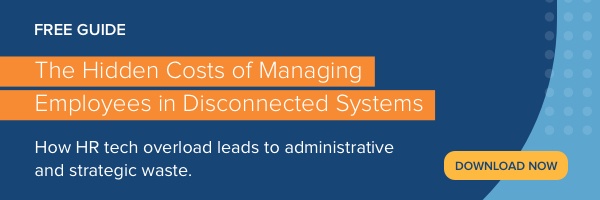A unified workforce management system ties together all of the core elements of a talent management system, including payroll, scheduling, leave management, time and attendance, and other essential HR services.
When all of these pieces are pulled together in one centralized platform, you can improve efficiency, do more with workforce data, and provide a positive employee experience.
10 Benefits of Unified Workforce Management Software
In a recent Capterra study, 91 percent of leaders of small and medium-sized businesses said that HR technology was critical to their business, but only 57 percent were currently using it. Great HR technology not only helps automate everyday workforce management tasks, but it also yields data to drive better decision-making. However, it can be difficult to realize these benefits if you’re using multiple systems that don’t integrate well and operate in silos.
To achieve maximum efficiency and get the most out of your HR technology, use integrated workforce management software. Unifying functions, such as applicant tracking, time and attendance, and payroll, breaks down the silos and pulls all of your critical workforce data into one system.
Here are the top 10 benefits you can expect from using a unified system:
1. Less Paperwork
A unified workforce management system automates more of your HR workflows, from recruiting to offboarding, so you can upload and access workforce data in the cloud rather than generate more paper files. Also, by storing data in the cloud and reducing the need for paper documents, you can conduct essential HR activities from any location and give remote employees better access to policies and helpful forms.
2. Less Duplication and Manual Entry
Once you set up a profile for each employee in your unified system, you can add or change information without duplicating the information in multiple systems. For example, instead of tracking paper resumes and candidate emails, you can use your unified software solution for applicant tracking. As you hire candidates, you can add more information to their existing profiles without re-entering information such as contact details and demographic information.
3. Consolidated Reporting
With a unified system, you can pull together more elements for reporting than you can when storing workforce data in multiple systems. With all of your workforce data in one centralized location, you can develop a more comprehensive picture of your employees and pull information such as compensation, performance history, location, manager, and training participation into one easy-to-read report. This enhanced reporting capability not only provides you with more data to support better decision-making, but it also enables you to provide managers with information they need about their teams.
4. More Consistent Updates
Under a unified software system, when an employee joins, terminates, or changes benefits elections, you make the change in one place, rather than in multiple payroll and HR systems. Not only does this save time and cut down on errors, but it also delivers the assurance that you don’t have conflicting information for the same employee in your system or corresponding reports.
5. Better Communication Between HR and Payroll Functions
When there’s a new hire or a change affecting an employee’s pay, it’s not uncommon for HR to communicate the update to the payroll function or enter changes directly into a payroll system. Unified workforce management software simplifies that process by integrating HR and payroll data into one system. As a result, everyone is looking at the same information, and there’s less likelihood of miscommunication or information getting lost in translation.
6. Improved Compliance
When your systems for payroll, benefits, and other HR services don’t communicate well with each other, it’s harder to pull together reports for compliance requirements. For example, the Affordable Care Act (ACA) requires organizations to report on employees' full-time status and the number of employees receiving company healthcare benefits. A unified system enables you to pull all data from one single platform, making it easier to create accurate reports and meet compliance requirements on time.
7. A Better Employee Experience
A 2020 Future Workplace survey of HR leaders found that improving the employee experience was their most critical initiative for the year. Unified workforce management software supports a better employee experience by putting more payroll and benefits information into employees’ hands. For example, when an employee has a salary or time-off question or needs a copy of a form, the self-service feature of a unified platform provides access to the information, so employees don’t have to ask HR.
8. Fewer Errors
Having a unified system where all of the various aspects of the employee experience are managed in one system cuts down on errors that can be both frustrating and distracting for everyone involved. With payroll, time and attendance, and benefits data integrated into one platform, you can cut down on errors such as incorrect paychecks and W-2s.
9. More Insights into Your Workforce
With more data and consistent reporting, you can better understand your workforce and see which programs and activities drive the best ROI. Robust dashboards and unified workforce reporting allow you to:
- Understand trends in areas such as hiring and turnover
- Measure spending on payroll, benefits, and training
- Track the success of workforce programs over time
10. An Elevated Reputation for HR
Having multiple disconnected HR and payroll systems can make it harder to provide actionable, timely data to business leaders. It can also lead to embarrassing mistakes. Conversely, when you have a reliable and unified system for all aspects of workforce management (and not just a few), you can exceed employee expectations and build a positive reputation for accuracy and efficiency.
Unify Your HR and Payroll Systems for Better Workforce Management
When you need to manage a busy HR or payroll function, operating multiple systems that don’t integrate well only wastes time and money. It can also prevent you from realizing your goals for better reporting and an enhanced employee experience. Alternatively, unified workforce management software allows you to consolidate a range of HR and payroll activities, so you can improve efficiency and data accuracy.
Using multiple systems to manage your workforce may be holding you back in more ways than you think. To learn more, read our e-book, The Hidden Costs of Managing Employees in Disconnected Systems.

